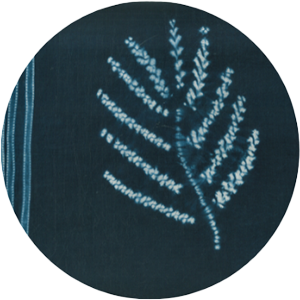The Shibori Craft
Shibori, from the root word Shiboru – “to wring, squeeze or press”, is a Japanese manual resist-dyeing technique, which produces a number of different patterns on fabric; in essence is a form of tie & dye in which the fabric is folded, pleated, tied or stitched in different ways to achieve various designs.
The Inimitable Charm of Shibori
The special attribute of Shibori is a soft or blurry-edged pattern, quite dissimilar from the sharp-edged features obtained with stencil, paste & wax. The Shibori artisan works in concert with the material, not strenuously overcoming its limitations, to allow them full expression. An element of the unanticipated is always present.
All the factors that influence the events in the dyeing vat conspire to withhold some of the control from the artisan’s hands. The semblance is that of a potter firing a wood-burning kiln. All the technical conditions have been met, but what happens in the kiln may either be a miracle or a disaster. Finesse and fortuity pair up to give life to the Shibori process. The same dye and the same technique never yield the same result twice.

A Constantly Evolving, Yet Deeply Rooted Design Philosophy
Mura has a design outlook that commences with all things natural. Our products are crafted largely from natural materials like organic cotton, raw silks like tussar, and blends like tussar-cotton and cotton-linen.
Design inspiration comes from the everyday, the mundane and the extravagant! Bodies that we interact with and experience. Whether it is the textures on a tree’s bark, patterns imagined in the clouds, the magnificent shapes and colours of birds, flowers, butterflies, or man made architectural forms. In effect, we do not create designs, but only get inspired, adapt and express through Shibori.
Types of Shibori practiced at Mura
1. Wood grain (Mokume Shibori)

A bunch of lines running parallel to one another are stitched with simple running stitches. The threads are then drawn up and tightened, leading to the fabric getting scrunched up. When dyed, the scrunched fabric transforms into a fascinating textural design in which every single piece is unique.
Mura’s first production in this design was for Fabindia, in 2005. The design was carried on a short ladies top & ran successfully for several years, year on year, without changes.
2. Ori-Nui & Maki Nui Shibori

These are straight running stitches made close to the edge of a fold, leading to 2 rows of charming symmetrical resisted marks. In Maki Nui Shibori, the stitches are made close to the edge, but using a twisted method of stitching. This results in a geometric chevron-like form that looks somewhat like a woven chevron.
3. Maki-age Shibori (Criss-cross binding)

Stitches are done around any shape, geometric or organic, and the thread is then drawn up to scrunch the area inside. A separate thread is bound in a criss-cross manner over the gathered area. The resulting design has a typical partly resisted and partly dyed look which is the characteristic of this form of Shibori.
4. Arashi Shibori

At Mura, we do variations of this Japanese technique using the wrapped and tied variation, as well as the pleated and tied variation.
5. Clamps Shibori (Itajime)

This family of designs, which are typically geometric and large in appearance, are achieved by broadly pleating and then folding cloth into a square, rectangular or triangular form. The neatly heaped and geometrically folded cloth is placed between shaped wooden blocks and clamped together using G-clamps. As only parts of the fabric area are exposed to the dye, there are large resisted geometric areas in these designs.
6. Mura Shibori** (Machine-stitch Shibori)

** Our signature style
Our signature style, Mura Shibori, is a layered and machine stitched technique of shibori. The fabric is transformed into a textural three-dimensional medium, with many layers of fabric dyed in differential tones, creating a beautiful interplay of light and dark shades.
7 . Miura Shibori

Miura shibori or looped binding involves taking a thread and binding small pinched areas with it in continuous sequence. This creates a freehand amorphous circular pattern. The thread is moved continuously from one circle to another, without being cut in between.
